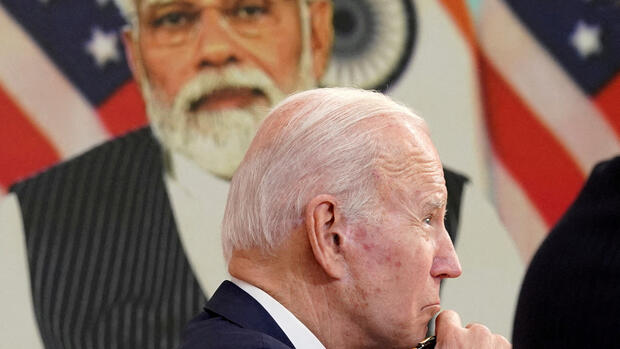The US President receives India’s Prime Minister Modi this Wednesday.
(Photo: REUTERS)
Bangkok The United States welcomes India’s Prime Minister Narendra Modi with great expectations: Jake Sullivan, US President Joe Biden’s national security adviser, enthused in the Indian press that there are no upper limits to the partnership between the two countries. Modi’s visit to New York and Washington, which begins on Wednesday, will be a springboard for US-Indian relations, predicted Ely Ratner, who is responsible for Indo-Pacific policy at the US Department of Defense.
There is a reason for the Biden government’s India euphoria: It sees the country with a population of 1.4 billion as the strongest partner in Asia to resolutely counter China’s striving for power on the continent – both politically and militarily.
Modi, who is controversial in his homeland because of his harsh treatment of critics, among other things, should therefore be courted in Washington. According to diplomatic protocol, the highest honor for a foreign guest of state is planned: an official state reception with a banquet in the White House and a speech by Modi to the US Congress.
Exclusive visiting program only for close allies
Normally, such an exclusive visit program in the USA is primarily reserved for close allies – since Biden took office, there have only been state receptions for French President Emmanuel Macron and South Korean President Yoon Suk Yeol. But it should not stop with diplomatic symbolism: US officials announced “substantial results” before the Biden-Modi meeting – with a clear focus on defense cooperation. The US is expected to pledge to significantly expand military technology transfer to India – and thereby strengthen India’s army.
The Indians’ shopping list includes the purchase of 30 armed combat drones, which could help India secure the disputed border with China in the Himalayas. Most important, however, is the plan to produce fighter jet engines from the US manufacturer General Electric (GE) in the future with a local partner in India.
>> Read also: Nuclear arms race accelerates
The US government has had a corresponding application for months – now, according to US media, the deal is ready to be signed. It would be of enormous importance for India’s armaments industry: Although it is able to supply the Indian military with locally manufactured combat aircraft, the country still has to buy the necessary engines from abroad.
Reduce India’s dependence on Russian armaments
In the USA, too, the planned production partnership between GE and India’s state-owned armaments company Hindustan Aeronautics is a big step: the engine technology is a strategic advantage for the USA, said security advisor Sullivan before the expected announcement of the cooperation. “Every technology transfer in this area is therefore a vote of confidence in the strategic partnership with another country.”
Closer cooperation is not only in the interest of both countries in view of the common concerns about China’s military power: the governments in Washington and New Delhi are also concerned with reducing India’s dependence on Russian armaments. While the USA hopes that this will increase Russia’s international isolation, India wants to diversify its sources of supply for military technology – also because Russian supplies have stagnated in the wake of the Ukraine war.
>> Read also: Boeing’s new drones should be able to do that soon
Germany also wants to help India: At the beginning of the month, Thyssen-Krupp Marine Systems agreed to transfer submarine building know-how to India. In the presence of Defense Minister Boris Pistorius, company boss Oliver Burkhard signed an agreement with a local shipbuilding group that is to build the submarines in India according to German construction and design specifications – provided the two companies are awarded the contract by the Indian government. Pistorius also announced relief for India when buying other German armaments.
“The deal could strengthen India’s defense industry for decades”
In the US, however, observers urge caution against over-zealousness in India’s rearmament: The US government must understand that India is not an ally and will never seek an alliance with the US, comments Daniel Markey, South Asia expert at the United States Institute of Peace. From his point of view, the currently good relations between the two countries are based on similar interests with regard to China, which both countries perceive as a threat.
In other areas, the differences are large – for example with regard to Modi’s increasingly authoritarian politics at home or India’s refusal to condemn Russia’s invasion of Ukraine. Markey believes that making India’s military more powerful by transferring engine technology could benefit the United States in the short term. “But the deal could strengthen India’s defense industry for decades, which may not be in the long-term interests of the United States.”
Sullivan wants to address the concerns
Before Modi’s visit to the United States, US security adviser Sullivan tried to dispel the concerns: The people of India and the United States see each other as natural partners – that helps to bridge all barriers.
However, public perception of India under the Modi government in the United States is not entirely uncritical: human rights activists are pushing for the controversial issues to be addressed during the state visit – Modi has been accused of, among other things, backsliding in press freedom and discrimination against Muslims. Activists are planning a Modi-critical rally near the White House on Thursday. They want to distribute flyers there with the inscription: “Modi Not Welcome”.
More: Pistorius advertises billion-dollar submarine deal in India
